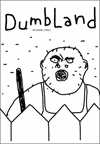Dumbland
David Lynch, that purveyor of cinematic weirdness ("Mulholland Drive, " "Lost Highway," "Twin Peaks") unleashes yet another artistic conundrum that will cause audiences to scratch their heads. "Dumbland" originated on the director's website as a series of eight short, Flash-animated cartoons and all have been collected here in their shoddy, black and white glory.
Before the main menu pops up, a brief message from Lynch fills the screen. It reads: "'Dumbland' is a crude, stupid, violent, absurd series. If it is funny, it is funny because we see the absurdity of it all." This description perfectly encapsulates the aesthetic qualities of Lynch's creation.
Each vignette focuses on our "hero," a lumbering, beer-guzzling oaf who suffers from rage issues. Most of what spews from his mouth are strings of curse words, usually spouted at high decibels. Speaking of his mouth, it's always agape, in the shape of an "O," highlighting the three random teeth he has left. His brow is always furrowed and his eyes down turned, communicating anger, apathy or lack of common understanding (or all of the above). The squiggle-like drawing (akin to the squiggle-vision technique used on "Dr. Katz" and the first season of "Home Movies") adds immediacy to the main character, perfectly capturing the anger boiling underneath his skin.
Living with our unnamed hero in this suburban wasteland is his wife, who is constantly fretting about something (perhaps frightened by what her husband will do next). Her hair sprouts from her head as if she's been electrocuted and she nervously speaks in high-toned gibberish. Although both the husband and wife are drawn in a rudimentary style, their son is even less detailed. Without any hands or clothes, he's basically a stick figure that has been slightly fleshed out. With a big head and large eyes, he resembles the standard concept of what a space alien looks like. He too has a high-pitched wail and usually repeats everything multiple times, to annoying effect.
Lynch has always skirted the line between the grotesque and the comical (check out Crispin Glover's bizarre cameo in "Wild at Heart" as an example) and "Dumbland" is no exception. Related to this are the inanities and mundane aspects of suburban life, where there lays an undercurrent of menace. The 1950's aesthetic of "Blue Velvet" and the jocular innocence of the locals in "Twin Peaks," as well as the glamour of Hollywood in "Mulholland Drive" all conceal the depravity that exists beneath the surface. "Dumbland" follows in these footsteps, bringing to the fore bizarre, violent situations that belie the normalcy of the surroundings.
Scattered throughout the shorts are instances of domestic abuse, a hyperactive treadmill, a sledgehammer stuck in our hero's ass, uncontrollable farting, electrocution, knife-stabbing, broken necks, eye-gouging, car crashes, face punching, more farting, vomiting and bug-spray induced hallucinations. The minimalist, child-like drawings add to the charm of the cartoons and, in the process, makes these violent outbursts less horrific. The innocence of the drawings (which look like doodles in a notebook) makes the "shock value" of the situations a moot point. In less stylized hands, this constant barrage of wayward bodily functions and out of control outbursts would be disturbing. Lynch utilizes these crude, sparse drawings to optimum effect. Solid, black lines communicate the bare essentials of the onscreen action. Details are left out, with only the basic tenets of the scenes catching our gaze.
Thematically, "Dumbland" is like a parallel-universe version of the cartoon "King of the Hill," only filtered through a sadist's mind.
Subversive Cinema presents "Dumbland" in a 1.33:1 full-frame aspect ratio. Each short is windowboxed, centered in the middle of the screen, bordered by black on each side. Unfortunately, this makes the shenanigans look like they're occurring inside a postage stamp. Originally intended for the internet, the images are surprisingly crisp and clean. Sharpness is optimal, with no edge enhancement apparent in any of the seemingly haphazard drawings.
What really stands out is the 5.1 Dolby Digital track. Lynch infuses each vignette with wildly diverse snippets of sounds. A hovering helicopter seesaws between the rear speakers, the passing of cars filter back and forth and the intense spurts of music kick in from all channels, then slowly dissipates to the right rear channel, quietly floating away.
Like most of Lynch's DVD releases, "Dumbland" arrives barebones. For only being 35 minutes long, it would have been nice to get some sort of supplemental material. Especially since this is a one-man show, with Lynch providing all the character voices, the drawings and the score. Any type of reflection on the work and the origins would have been ideal. Alas, we will just have to imagine what percolates inside that mind of his.
"Dumbland," is a crude, poorly drawn cartoon that somehow transcends its misleading aesthetic qualities. With an impressive pedigree behind it, the bizarre antics take on a whole other level of significance. While this can be detrimental (maybe Lynch just wanted to make a stupid cartoon and not necessarily a comment on suburban life), the shear audacity and giddy joy that seeps through the situations can be infectious. For those familiar with his off-kilter style, then "Dumbland" will provide a solid viewing experience. But, if you're not in the mood for random acts of violence and flatulence, look elsewhere.







